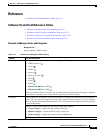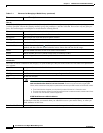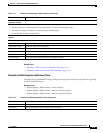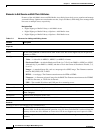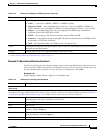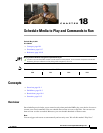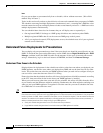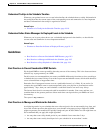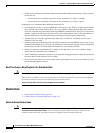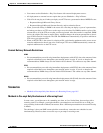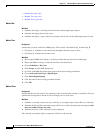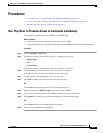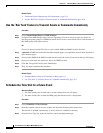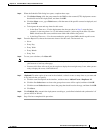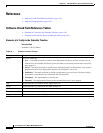
18-3
User Guide for Cisco Digital Media Manager 5.2.x
OL-15762-03
Chapter 18 Schedule Media to Play and Commands to Run
Concepts
Understand Tooltips in the Schedule Timeline
Whenever your pointer hovers over a event in the timeline, the schedule shows a tooltip. Information in
the tooltip describes the current status of the corresponding event and summarizes its most important
attributes. Information in the tooltip is organized as follows.
Related Topics
• Elements of a Tooltip in the Schedule Timeline, page 18-10
Understand Inline Status Messages for Deployed Events in the Schedule
Whenever you let your pointer hover over a scheduled deployment in the timeline, we describe the
current status and summarize its most important attributes.
Related Topics
• Elements to Describe the Status of Deployed Events, page 18-11
Guidelines
• Best Practices to Prevent Unscheduled DMP Restarts, page 18-3
• Best Practices to Manage and Maintain the Schedule, page 18-3
• Best Practices to Stop Playback of a Scheduled Job, page 18-4
Best Practices to Prevent Unscheduled DMP Restarts
We designed DMPs to restart gracefully when they run out of free memory. This is the fastest and most
effective way to purge memory on a DMP.
For this reason, we recommend that you restart your DMPs deliberately from time to time, according to
a schedule that you control. Doing so can reduce or prevent unscheduled restarts, which could otherwise
occur at inconvenient or inopportune times.
Determine first if unexpected restarts occur at a predictable interval, as is likely. If you notice, for
example, that your DMPs seem to restart unexpectedly after your playlists or presentations run for
approximately 7 days, then you could schedule a controlled restart to run once every 6 days.
The interval that’s best for one network could be unsuitable for another. Your assets and how you
combine them are the greatest predictor of how much time can elapse before your DMPs run out of
free memory.
The syntax is
mng.reboot=1.
Best Practices to Manage and Maintain the Schedule
Avoid placing entries in your schedule that recur often and persist for an unreasonably long time, and
also avoid all other practices that might cause your schedule to become too large. Otherwise, DMM
might not generate your manifest files quickly enough and your ACNS CDM or root CE might time out.
We recommend that you apply this rough algorithm:
• An entry that recurs daily should persist in your schedule for no more than 3 days.
• An entry that recurs weekly should persist in your schedule for no more than 3 weeks.



